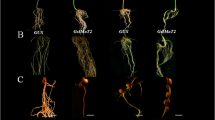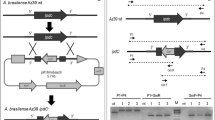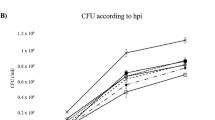Abstract
Flavonoids released by roots of Vicia sativa subsp. nigra (V. sativa) activate nodulation genes of the homologous bacterium Rhizobium leguminosarum biovar viciae (R. l. viciae). Inoculation of V. sativa roots with infective R. l. viciae bacteria largely increases the nod gene-inducing ability of V. sativa root exudate (A.A.N. van Brussel et al., J Bact 172: 5394–5401). The present study showed that, in contrast to sterile roots and roots inoculated with R. l. viciae cured of its Sym plasmid, roots inoculated with R. l. viciae harboring its Sym plasmid released additional nod gene-inducing flavonoids. Using 1H-NMR, the structures of the major inducers released by inoculated roots, 6 flavanones and 2 chalcones, were elucidated. Roots extracts of (un)inoculated V. sativa contain 4 major non-inducing, most likely glycosylated, flavonoids. Therefore, the released flavonoids may either derive from the root flavonoids or inoculation with R. l. viciae activates de novo flavonoid biosynthesis.
Similar content being viewed by others
References
Carlson RE, Dolphin DH: Pisum sativum stress metabolites: two cinnamylphenols and 2′-methoxychalcone. Phytochemistry 21: 1733–1736 (1982).
Dart PJ: The infection process. In: Quispel A (ed) The Biology of Nitrogen Fixation, pp. 381–429. North-Holland, Amsterdam/Oxford (1975).
Diaz CL, Melchers LS, Hooykaas PJJ, Lugtenberg BJJ, Kijne JW: Root lectin as a determinant of host-plant specificity in the Rhizobium-legume symbiosis. Nature 338: 579–581 (1989).
Dixon RA: The phytoalexin response: Elicitation, signalling, and control of host gene expression. Biol Rev 61: 239–291 (1986).
Djordjevic MA, Redmond JW, Batley M, Rolfe BG: Clovers secrete specific phenolic compounds which either stimulate or repress nod gene expression in Rhizobium trifolii. EMBO J 6: 1173–1179 (1987).
Djordjevic MA, Schofield PR, Rolfe BG: Tn5 mutagenesis of R. trifolii host-specific nodulation genes result in mutants with altered host-range ability. Mol Gen Genet 200: 463–471 (1985).
Firmin JL, Wilson KE, Rossen L, Johnston AWB: Flavonoid activation of nodulation genes in Rhizobium reversed by other compounds present in plants. Nature 324: 90–92 (1986).
Heller W, Forkmann G: Biosynthesis. In: Harborne JB (ed) The Flavonoids: Advances in Research since 1980, pp. 399–427. Chapman and Hall, London/New York (1988).
Hooykaas PJJ, vanBrussel AAN, denDulk-Ras H, vanSlogteren GMS, Schilperoort RA: Sym plasmid of Rhizobium trifolii expressed in different rhizobial species and Agrobacterium tumefaciens. Nature 291: 351–353 (1981).
Horvath B, Bachem CW, Schell J, Kondorosi A: Hostspecific regulation of nodulation genes in Rhizobium is mediated by a plant-signal, interacting with the nodD gene product. EMBO J 6: 841–848 (1987).
Johnston AWB, Beynon JL, Buchanon-Wollaston AV, Setchell SM, Hirsch PR, Beringer JE: High frequency transfer of nodulating ability between strains and species of Rhizobium. Nature 276: 634–636.
Kapulnik Y, Joseph CM, Phillips DA: Flavone limitations to root nodulation and symbiotic nitrogen fixation in alfalfa. Plant Physiol 84: 1193–1196 (1987).
Kosslak RM, Bookland R, Barkei J, Paaren HE, Appelbaum ER: Induction of Bradyrhizobium japonicum common nod genes by isoflavones isolated from Glycine max. Proc Natl Acad Sci USA 84: 7428–7432 (1987).
Lerouge P, Roche P, Faucher C, Maillet F, Truchet G, Prome JC, Denarie J: Symbiotic host-specificity of Rhizobium meliloti is determined by a sulphated and acetylated glucosamine oligosaccharide signal. Nature 344: 781–784 (1990).
Marbry TJ, Markham KR, Thomas MB: The Systematic Identification of Flavonoids. Springer-Verlag, Berlin/Heidelberg/New York (1970).
Maxwell CA, Hartwig UA, Joseph CM, Phillips DA: A chalcone and two related flavonoids released from alfalfa roots induce nod genes of Rhizobium meliloti. Plant Physiol 91: 842–847 (1989).
Peters KN, Long SR: Alfalfa root exudates and compounds which promote or inhibit induction of Rhizobium meliloti nodulation genes. Plant Physiol 88: 396–400 (1988).
Peters KN, Frost JW, Long SR: A plant flavone, luteolin, induces expression of Rhizobium meliloti genes. Science 233: 977–980 (1986).
Redmond JW, Batley M, Djordjevic MA, Innes RW, Kuempel PL, Rolfe BG: Flavones induce expression of nodulation genes in Rhizobium. Nature 323: 632–635 (1986).
Rolfe BG, Sargent CL, Weinman JJ, Djordjevic MA, McIver J, Redmond JW, Batley M, Yuan DC, Sutherland MW: Signal Exchange between R. trifolii and clovers. In: Lugtenberg BJJ (ed) Signal Molecules in Plants and Plant-Microbe Interactions, pp. 303–310. Springer-Verlag, Berlin/Heidelberg (1989).
Sharma SB, Signer ER: Temporal and spatial regulation of the symbiotic genes of Rhizobium meliloti in planta revealed by transposon Tn5-gusA. Genes Devel 4: 344–356 (1990).
Smit G, Logman TJJ, Boerrigter METI, Kijne JW, Lugtenberg BJJ: Purification and partial characterization of the Rhizobium leguminosarum biovar viciae Ca2+-dependent Adhesin, which mediates the first step in attachment of cells of the family Rhizobiaceae to plant root hair tips. J Bact 171: 4054–4062 (1989).
Spaink HP, Okker RJH, Wijffelman CA, Pees E, Lugtenberg BJJ: Regulation of the promoters in the nodulation of the symbiosis plasmid pRL1JI of Rhizobium leguminosarum. In: Verma DPS, Brisson N (eds) Molecular Genetics of Plant-Microbe Interactions, pp. 244–246. Martinus Nijhoff, Dordrecht (1987).
Spaink HP, Weinman J, Djordjevic MA, Wijffelman CA, Okker RJH, Lugtenberg BJJ: Genetic analysis and cellular localization of the Rhizobium host specificity-determining NodE protein. EMBO J 8: 2811–2818 (1989).
Spaink HP, Wijffelman CA, Okker RJH, Lugtenberg BJJ: Localization of functional regions of the Rhizobium nodD product using hybrid nodD genes. Plant Mol Biol 12: 59–73 (1989).
VanBatenburg FHF, Jonker R, Kijne JW: Rhizobium induces marked root hair curling by redirection of tip growth: a computer simulation. Physiol Plant 66: 476–480 (1986).
vanBrussel AAN, Zaat SAJ, Canter Cremers HCJ, Wijffelman CA, Pees E, Tak T, Lugtenberg BJJ: Role of plant root exudate and Sym plasmid-localized nodulation genes in the synthesis by Rhizobium leguminosarum of Tsr factor which causes thick and short roots on common vetch. J Bact 165: 517–522 (1986).
VanBrussel AAN, Recourt K, Pees E, Spaink HP, Tak T, Wijffelman CA, Kijne JW, Lugtenberg BJJ: A biovarspecific signal of Rhizobium leguminosarum biovar viciae induces increased nodulation gene-inducing activity in root exudate of Vicia sativa subs. nigra. J Bact 172: 5394–5401 (1990).
Vansumere CF, Vandecasteele K, Hutsebaut W, Evaert E, deCooman L, Meulemans W: RP-HPLC Analysis of flavonoids and the biochemical identification of hop cultivars. In: Carl H (ed) Proceedings of the EBC Symposium on Hops, pp. 146–175. Brauwelt Verlag, Nürnberg (1988).
Vincent JM: Factors controlling the legume-Rhizobium symbiosis. In: Newton WE, Orme-Johnston (eds) Nitrogen Fixation, pp. 103–129. University, Park Press, Baltimore, MD (1980).
Wijffelman CA, Zaat B, Spaink H, Mulders I, vanBrussel AAN, Okker R, DeMaagd R, Lugtenberg BJJ: Induction of Rhizobium nod genes by flavonoids: differential adaptation of promoter, nodD gene and inducers for various cross-inoculation groups: In: Lugtenberg B (ed) Recognition in Microbe-Plant Symbiotic and Pathogenic Interactions. NATO ASI Series, Vol H 4, pp. 123–135. Springer-Verlag, Berlin/Heidelberg (1986).
Zaat SAJ, Wijffelman CA, Spaink HP, vanBrussel AAN, Okker RJH, Lugtenberg BJJ: Induction of the nodA promoter of Rhizobium leguminosarum Sym plasmid pRL1JI by plant flavanones and flavones. J Bact 169: 198–204 (1987).
Zaat SAJ, Wijffelman CA, Mulders IHM, VanBrussel AAN, Lugtenberg BJJ: Root exudates of various host plants of Rhizobium leguminosarum contain different sets of inducers of Rhizobium nodulation genes. Plant Physiol 86: 1298–1303 (1988).
Zaat SAJ, Schripsema J, Wijffelman CA, vanBrussel AAN, Lugtenberg BJJ: Analysis of the major inducers of the Rhizobium nodA promoter from Vicia sativa root exudate and their activity with different nodD genes. Plant Mol Biol 13: 175–188 (1989).
Author information
Authors and Affiliations
Rights and permissions
About this article
Cite this article
Recourt, K., Schripsema, J., Kijne, J.W. et al. Inoculation of Vicia sativa subsp. nigra roots with Rhizobium leguminosarum biovar viciae results in release of nod gene activating flavanones and chalcones. Plant Mol Biol 16, 841–852 (1991). https://doi.org/10.1007/BF00015076
Received:
Accepted:
Issue Date:
DOI: https://doi.org/10.1007/BF00015076




